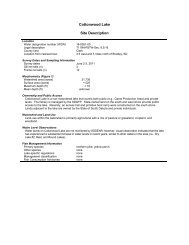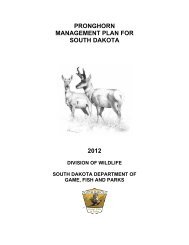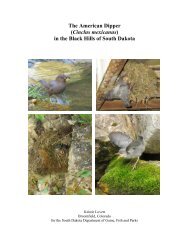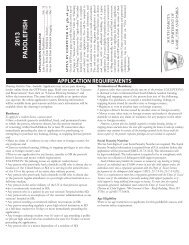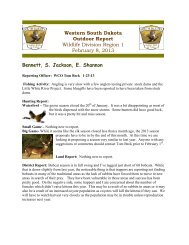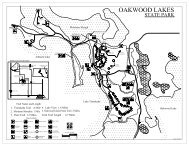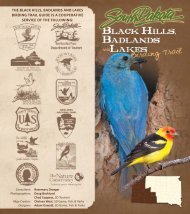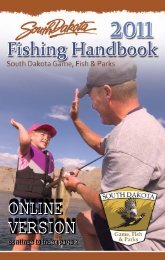pdf version - South Dakota Department of Game, Fish and Parks
pdf version - South Dakota Department of Game, Fish and Parks
pdf version - South Dakota Department of Game, Fish and Parks
You also want an ePaper? Increase the reach of your titles
YUMPU automatically turns print PDFs into web optimized ePapers that Google loves.
Bluegill<br />
Lepomis macrochirus<br />
Quick key characteristics: The bluegill is found in cool- to warm-water habitats.<br />
Its scales are moderate in size <strong>and</strong> readily visible. It has two elongated dorsal fi ns<br />
that are joined <strong>and</strong> appear as one, one (in front) with sharp spines instead <strong>of</strong> rays.<br />
It has three spines in the anal fi n <strong>and</strong> one in each pelvic fi n. It has a small, forwardfacing<br />
mouth, which rarely extends backward as far as the front margin <strong>of</strong> the eye.<br />
Its snout is pointed <strong>and</strong> its body is much taller than wide.<br />
Similar species in <strong>South</strong> <strong>Dakota</strong>: other sunfi sh, rock bass<br />
Identifi cation: The combination <strong>of</strong> (1) a small mouth, (2) very fl exible, black<br />
opercle fl ap (ear), (3) long, pointed pectoral fi ns, (4) black spot near rear base<br />
<strong>of</strong> second dorsal fi n, <strong>and</strong> (5) vertical bars on body distinguishes the bluegill<br />
from similar fi shes in <strong>South</strong> <strong>Dakota</strong>.<br />
Range: The bluegill is native to southeastern North America, north to the<br />
Great Lakes <strong>and</strong> west to the Great Plains. In <strong>South</strong> <strong>Dakota</strong>, it is native to<br />
waters <strong>of</strong> the Minnesota <strong>and</strong> Big Sioux river basins, but has been introduced<br />
elsewhere. It is <strong>of</strong>ten abundant in ponds, lakes, <strong>and</strong> impoundments.<br />
Items <strong>of</strong> interest:<br />
• Feeds on plankton, insects, crustaceans, <strong>and</strong> small fi shes<br />
• May reach high population densities that stunt growth<br />
• Breeding males may have an orange<br />
or rust-colored breasts <strong>and</strong> bluish<br />
sheen elsewhere<br />
• Males construct <strong>and</strong> defend nests <strong>and</strong><br />
guard eggs <strong>and</strong> hatchlings<br />
• Often hybridizes with other species<br />
<strong>of</strong> sunfi sh<br />
• May reach 11 in. <strong>and</strong> exceed 2 lb<br />
54






